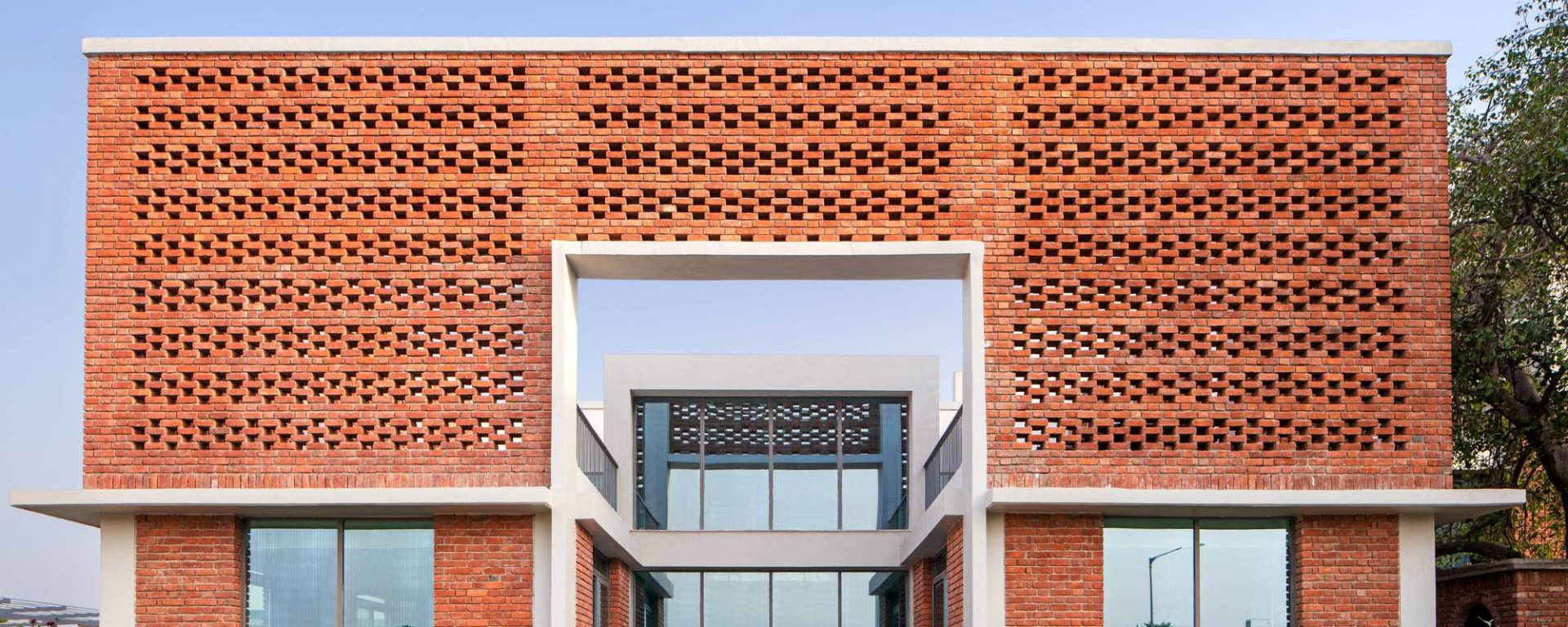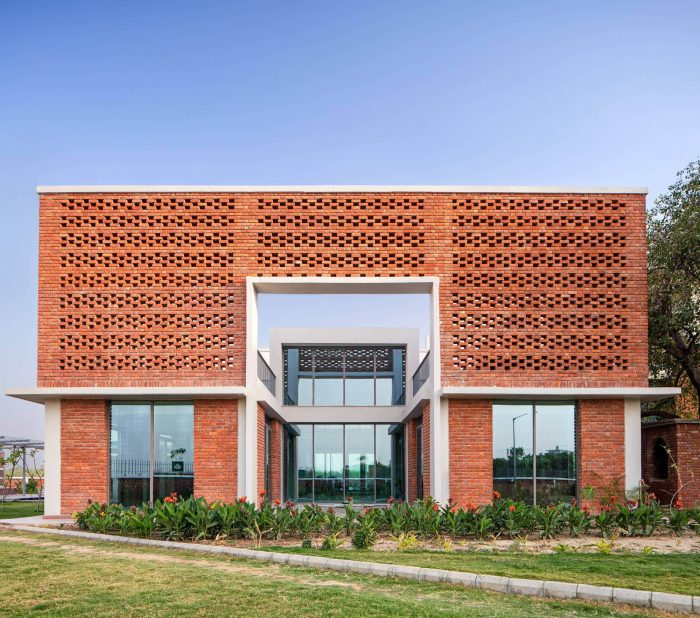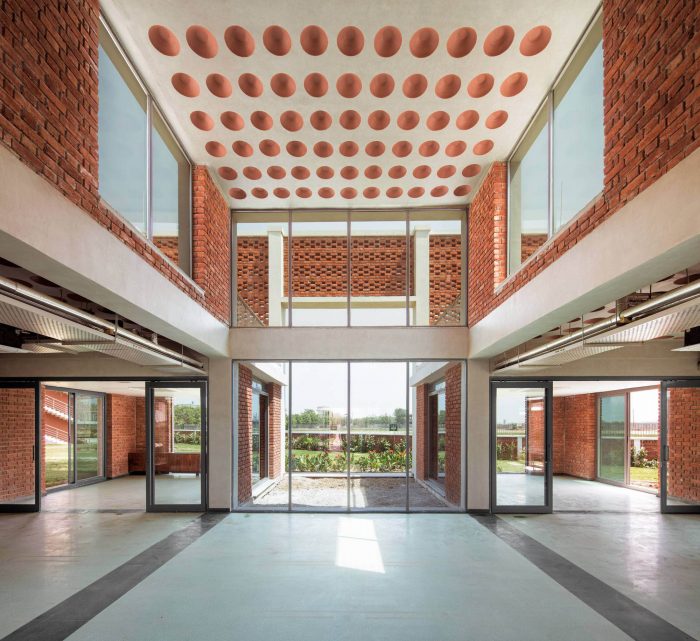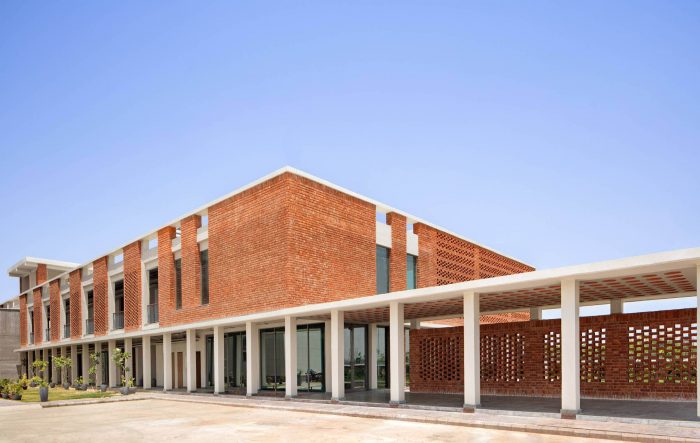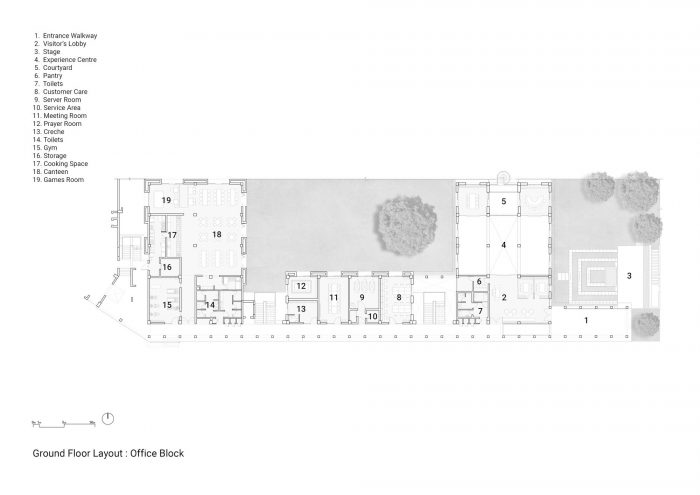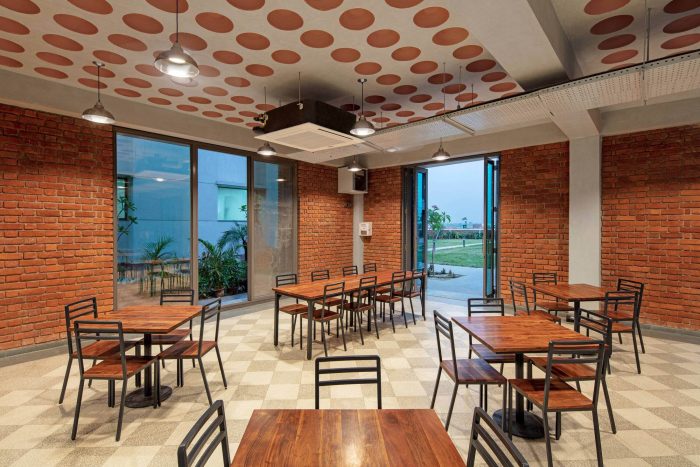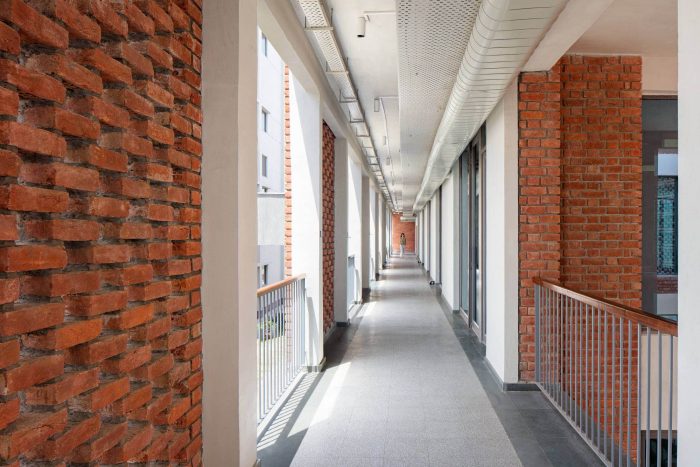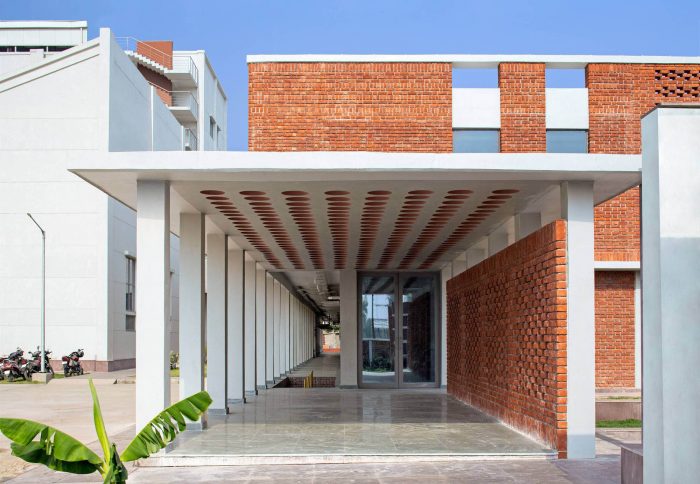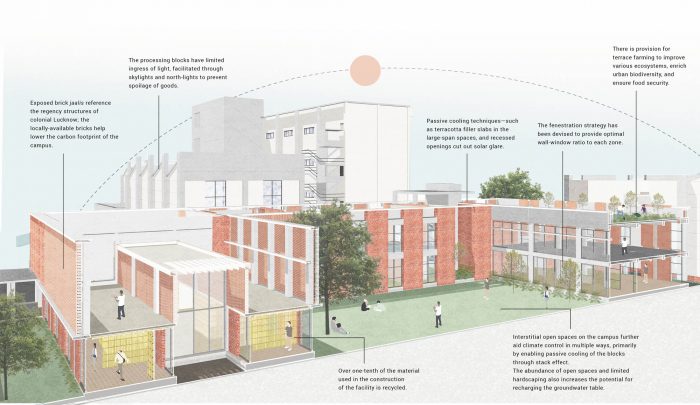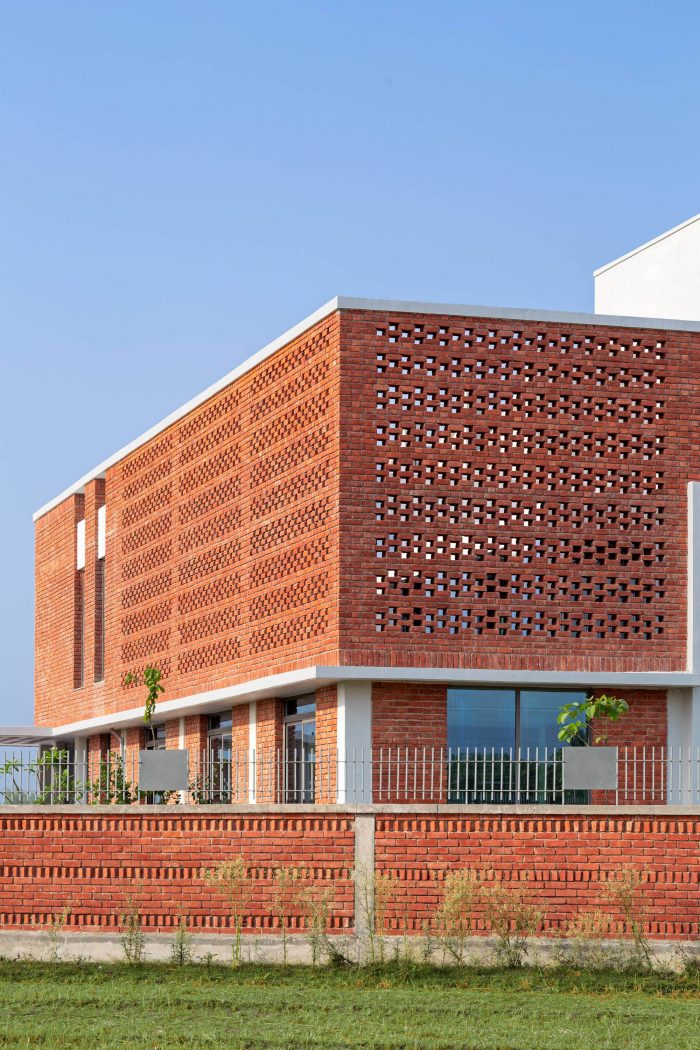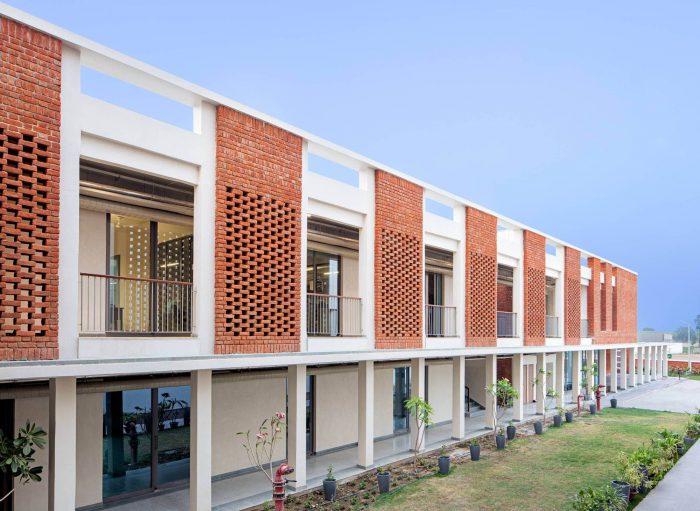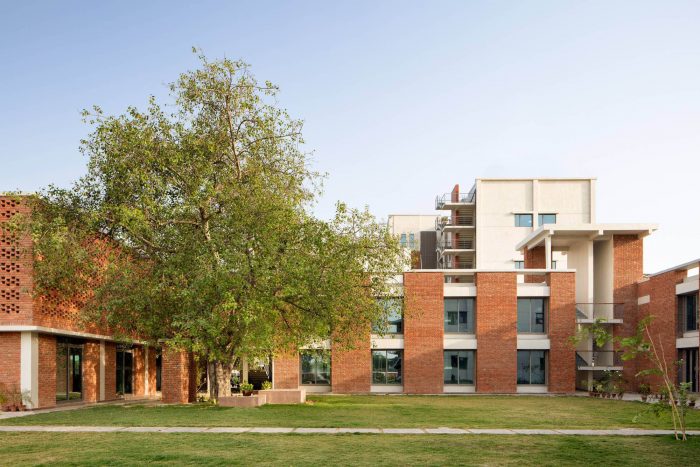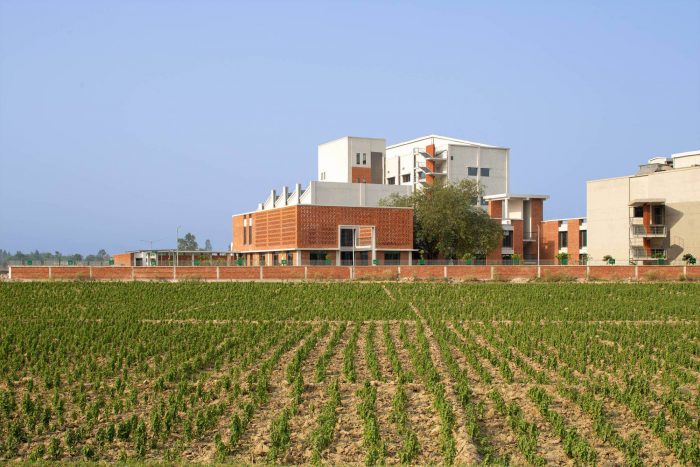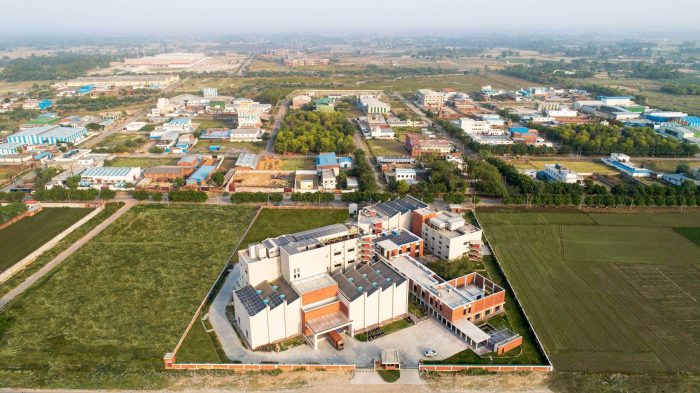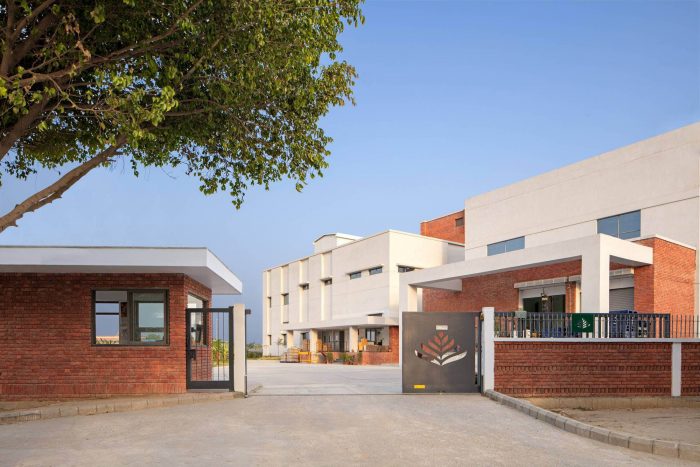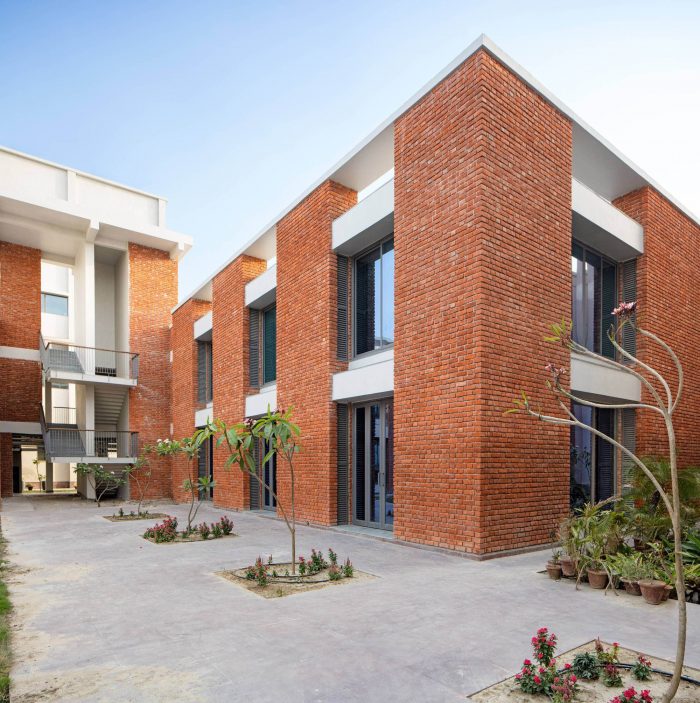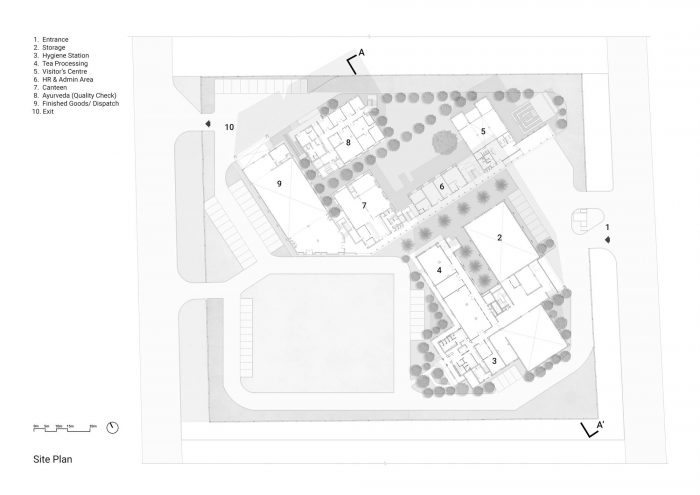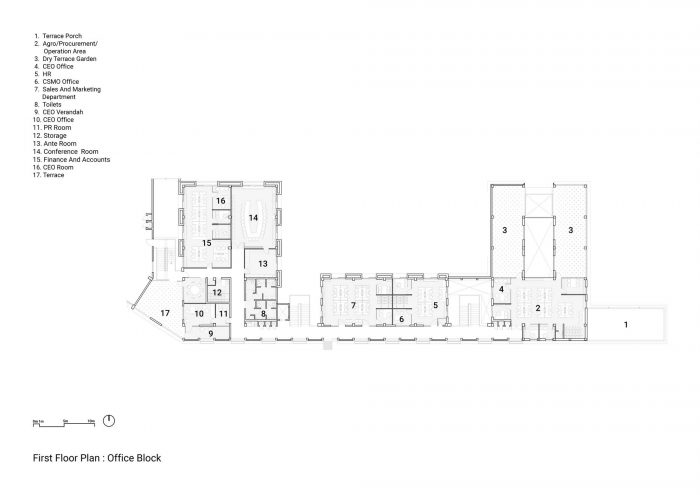位于勒克瑙的有机印度综合生产设施是一个园区,旨在支持整体健康品牌的生产、加工和管理功能。两组相交的轴线构成了该设施的建筑足迹;由此产生的间隙空间以庭院、采光井和草坪的形式出现,为设施工作人员提供了互动和放松的空间。该设施的建筑语汇是用砖和混凝土来表达的,流线型的线条和平面对称性是外立面设计的特点。
The Integrated Production Facility for Organic India in Lucknow is a campus designed to support the production, processing, and administrative functions for the holistic wellness brand. Two sets of intersecting axes characterize the building footprint of the facility; the resulting interstitial spaces emerge as courtyards, lightwells, and lawns that provide space for interaction as well as relaxation to the facility staff. The built vocabulary of the facility is articulated in brick and concrete, with sleek lines and planar symmetry characterizing the facade design.
从程序上看,建筑由生产翼、成品区、质量控制部、被棋盘式砖幕包裹的体验中心、行政设施以及为员工提供的辅助功能组成,其中包括会议室、食堂和健身房。与加工翼的整体外观不同,办公室的建筑语汇是多孔的、复合的。
Programmatically, the building comprises of the Production Wing, the Finished Goods Block, the Quality Control Department, an experience centre wrapped in a tessellated brick screen, administrative facilities, and ancillary functions for the staff, which include a meeting room, a cafeteria and a gym. In contrast to the monolithic appearance of the processing wings, the built vocabulary of the offices is porous and composite.
设计方案吸收了当地的影响,以创造一个可持续的建筑环境,其中最主要的是使用砖作为填充材料。砖的外壳暴露在外,让人联想到勒克瑙殖民时期的摄政结构;由于当地有丰富的劳动密集型窑炉和柔韧的粘土,砖也是当地的,这降低了园区的碳足迹。为了给每个区域提供最佳的墙窗比,设计了围合策略:加工区通过天窗和北面的灯光,限制了光线的进入,以防止货物变质。
The design scheme imbibes local influences to create a sustainable built environment, the primary among these being the use of bricks as an infill material. Left exposed, the facility’s brick shell harkens to the regency structures of colonial Lucknow; bricks are also locally available due to abundance of labour-intensive kilns and availability of pliable clay, lowering the carbon footprint of the campus. The fenestration strategy, in tune, has been devised to provide the optimal wall-window ratio to each zone: the processing blocks have limited ingress of light, facilitated through skylights and north lights, to prevent spoilage of goods.
另一方面,行政楼的采光率较高,有助于降低对人工照明的依赖。园区内的空地进一步有助于气候控制,主要是通过叠加效应使建筑群被动冷却。丰富的开放空间和有限的硬质景观也增加了对地下水位的补给潜力。此外,设计方案还采用了一系列的被动冷却技术–例如在大跨度空间中使用赤陶填充板,并采用凹陷的开口以减少太阳光。在该设施的建设中,超过十分之一的材料被回收利用;这些干预措施以及其他措施使该项目获得了LEED白金级评级。
On the other hand, high ingress of light is enabled in the administrative blocks, to help lower dependence on artificial lighting. The interstitial open spaces on campus further aid climate control, primarily by enabling passive cooling of the blocks through stack effect. The abundance of open spaces and limited hardscaping also increases potential for recharging the ground water table. The design scheme utilizes, in addition, a gamut of passive cooling techniques—such as terracotta filler slabs in the large-span spaces, and recessed openings to cut out solar glare. Over one-tenth of the material used in the construction of the facility is recycled; these interventions, among others have accorded the project a LEED Platinum rating.
该项目还非常注重创造一个好客的用户体验;精心设计的细节符合国际卫生标准。所有内部服务设施的设计都保证了清洁、无尘的角落。项目的无等级规划通过将中央建筑打造成一个聚会空间,将管理层和工厂工人聚集在一起。此外,该方案还包含了卡车司机的辅助规定,包括休息、放松、用餐和洗涤的区域。这些干预措施使园区产生了此类建筑类型所不具备的社会包容性。宽敞的开放空间、可渗透的建筑结构、对社区和内省的关注,以及将工人的安全和舒适性放在首位,这些都为该公司未来的所有物业创造了一个建筑模板。
The project also has a paramount focus on creating a hospitable user experience; careful details have been put in place to meet international standards for hygiene. All the internal services are designed to ensure clean, dust-free corners. The project’s hierarchy-free planning brings the management and the factory workers together by creating the central building as a congregational space. Furthermore, the programme encompasses ancillary provisions for truck drivers to include areas for rest, relaxation, dining, and washing. These interventions allow for the campus to engender social inclusivity uncharacteristic in such building types. The expansive open spaces, permeable built fabric, focus on community and introspection, and prioritization of the workers’ safety and comfort over all else has created an architectural template for all future properties for the company.
建筑师:Studio Lotus
面积:1200000平方英尺
年份:2019年
摄影:Andre J. Fanthome
制造商:Asian Paints, Bezel Designs, Bharat Flooring Tiles, Blue Star, Fabindia, Jacquar, Kajaria, Pallavi Aggarwal, Philips, SKK, Spectrum, St. Gobain, Ultratech and ACC, Wipro
设计团队:Sidhartha Talwar, Ambrish Arora, Nitika Srivastava, Raman Vig
客户:Bharat Mitra & Bhavani Lev
结构:NNC
机械:Blue Star
电气:Blue Star
民用:Dynacon India Pvt Ltd
景观:Roha Landscapes
暖通空调:Blue Star
管道:Blue Star
PMC:ENAR Consultants
能源:EDS GLOBAL
内饰:Star Infra
城市:Lucknow
国家:印度
Architects: Studio Lotus
Area: 1200000 ft²
Year: 2019
Photographs: Andre J. Fanthome
Manufacturers: Asian Paints, Bezel Designs, Bharat Flooring Tiles, Blue Star, Fabindia, Jacquar, Kajaria, Pallavi Aggarwal, Philips, SKK, Spectrum, St. Gobain, Ultratech and ACC, Wipro
Design Team:Sidhartha Talwar, Ambrish Arora, Nitika Srivastava, Raman Vig
Client:Bharat Mitra & Bhavani Lev
Structural:NNC, NNC
Mechanical:Blue Star, Blue Star
Electrical:Blue Star, Blue Star
Civil:Dynacon India Pvt Ltd, Dynacon India Pvt Ltd
Landscape:Roha Landscapes, Roha Landscapes
HVAC:Blue Star, Blue Star
Plumbing:Blue Star, Blue Star
PMC:ENAR Consultants, ENAR Consultants
Energy:EDS GLOBAL
Interiors:Star Infra
City:Lucknow
Country:India

